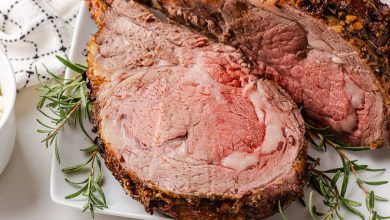Pumpernickel Bread (Toasted) – Nutritional Information
Pumpernickel bread is a delightful, dense, and flavorful bread often enjoyed toasted for breakfast or as a savory accompaniment to meals. It is rich in fiber, providing a hearty option for those seeking to boost their nutrient intake with wholesome ingredients. Whether you pair it with cheese, spreads, or just enjoy it on its own, pumpernickel bread offers an earthy taste that can elevate your dishes. Below is a detailed breakdown of the nutritional content per serving:
Nutritional Information (per 100g of toasted pumpernickel bread)
| Nutrient | Amount |
|---|---|
| Energy | 275 kcal |
| Protein | 9.5 g |
| Fat | 3.4 g |
| Saturated Fat | 0.481 g |
| Carbohydrates | 52.2 g |
| Fiber | 7.1 g |
| Sugar | 0.58 g |
| Calcium | 74 mg |
| Iron | 3.15 mg |
| Magnesium | 60 mg |
| Phosphorus | 195 mg |
| Potassium | 228 mg |
| Sodium | 655 mg |
| Zinc | 1.62 mg |
| Copper | 0.315 mcg |
| Manganese | 1.434 mg |
| Selenium | 26.9 mcg |
| Vitamin C | 0.0 mg |
| Thiamin (Vitamin B1) | 0.287 mg |
| Riboflavin (Vitamin B2) | 0.301 mg |
| Niacin (Vitamin B3) | 3.057 mg |
| Vitamin B6 | 0.124 mg |
| Folate | 26 mcg |
| Vitamin B12 | 0.0 mcg |
| Vitamin A | 0.0 mcg |
| Vitamin E | 0.46 mg |
| Vitamin D2 | 0.0 mcg |
Health Benefits and Dietary Considerations
1. High Fiber Content
Pumpernickel bread is an excellent source of dietary fiber, with 7.1 grams per 100 grams. Fiber is known to aid in digestion and support a healthy gut, promoting regular bowel movements and potentially lowering the risk of digestive diseases.
2. Rich in Essential Minerals
This bread provides important minerals, including calcium (74 mg), iron (3.15 mg), magnesium (60 mg), and phosphorus (195 mg), all of which are vital for maintaining healthy bones, teeth, and muscle function. The iron content is particularly beneficial for individuals looking to boost their iron intake, especially those on plant-based diets.
3. Protein-Rich
With 9.5 grams of protein per 100 grams, pumpernickel bread is a good plant-based protein source, supporting muscle repair and immune function. This makes it a great choice for those looking to incorporate more protein into their diet.
4. Moderate Fat Content
The bread contains 3.4 grams of total fat per serving, with only 0.481 grams of saturated fat, making it a relatively heart-healthy choice compared to other types of bread. Moderation is key when consuming fats, and pumpernickel offers a balanced ratio of healthy fats.
5. Low in Sugars
With just 0.58 grams of sugar per 100 grams, pumpernickel bread is a great choice for those looking to minimize their sugar intake. This makes it a suitable option for individuals following low-sugar or low-glycemic diets.
6. B-Vitamins for Energy
Pumpernickel bread contains a variety of B-vitamins, including thiamin (0.287 mg), riboflavin (0.301 mg), niacin (3.057 mg), and vitamin B6 (0.124 mg). These vitamins play crucial roles in energy production and maintaining healthy skin, nerves, and red blood cells.
Allergen Information
Pumpernickel bread typically contains the following allergens:
- Gluten: Since pumpernickel is made with rye flour, it is not suitable for individuals with celiac disease or a gluten intolerance.
- Wheat: Some variations of pumpernickel bread may include wheat flour, which should be noted for individuals with a wheat allergy.
Please check the ingredient list for any specific variations, especially if the bread is produced in facilities that also handle other allergens such as dairy, soy, or nuts.
Dietary Preferences
- Vegetarian: Pumpernickel bread is generally vegetarian-friendly, though it’s always good to verify the ingredients in case any animal-based additives (like certain preservatives or dough conditioners) are used.
- Vegan: Pumpernickel bread can be vegan, depending on the recipe used. Some recipes may include dairy or honey, so be sure to confirm whether the specific version you’re purchasing or making adheres to a vegan diet.
- High-Fiber Diets: With its impressive fiber content, pumpernickel bread is an excellent choice for those looking to increase their fiber intake.
- Low-Sodium Diets: With 655 mg of sodium per 100g, pumpernickel bread may be higher in sodium than some other bread options, so it might not be ideal for individuals on very low-sodium diets.
Tips and Serving Suggestions
-
Perfect Toast: Pumpernickel bread is delicious when toasted. Its dense texture and earthy flavor pair wonderfully with a variety of spreads, such as cream cheese, butter, or avocado. You can also top it with smoked salmon or turkey slices for a savory treat.
-
Pair with Soups and Stews: Pumpernickel bread is ideal for dipping in soups and stews, adding a hearty and satisfying texture. It pairs especially well with rich, creamy soups like butternut squash or lentil soup.
-
Create a Sandwich: Use toasted pumpernickel for a more robust sandwich base, filling it with your favorite deli meats, cheeses, and vegetables for a filling meal.
Conclusion
Toasted pumpernickel bread offers a satisfying, flavorful, and nutritious option that can complement a variety of dishes. Rich in fiber and essential nutrients, it provides a hearty addition to your diet, supporting digestive health and overall well-being. Whether you’re enjoying it as part of a savory meal or as a quick snack, pumpernickel bread’s unique taste and texture are sure to be a hit with your taste buds.










